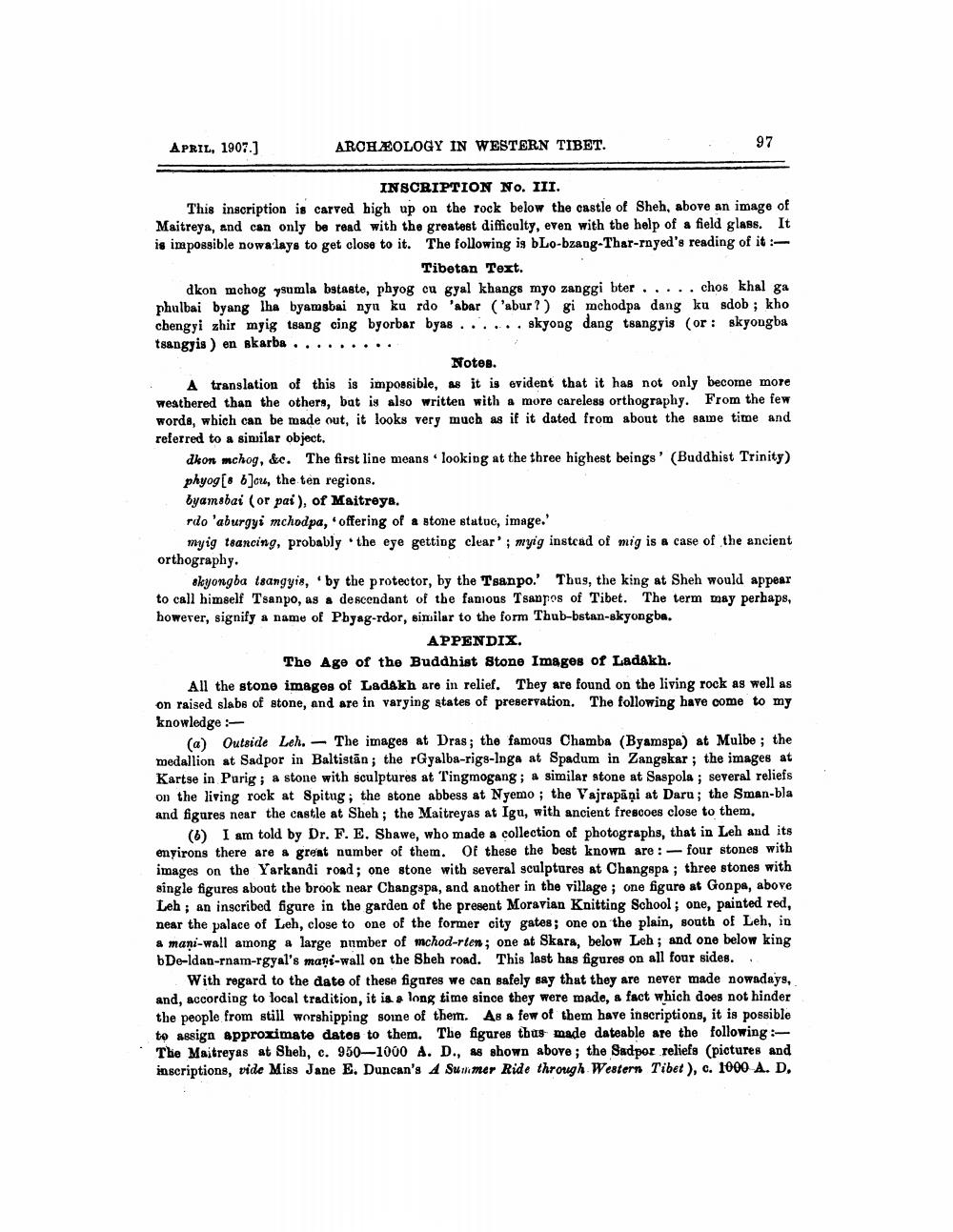________________
APRIL, 1907.)
ARCHÆOLOGY IN WESTERN TIBET.
.
97
INSCRIPTION No. III. This inscription is carved high up on the rock below the castle of Sheh, above an image of Maitreya, and can only be read with the greatest difficulty, even with the help of a field glass. It is impossible nowa lays to get close to it. The following is bLo-bzang-Thar-rnyed's reading of it :
Tibetan Text. dkon mchog yumla bataste, phyog cu gyal khangs myo zanggi bter ..... chos khal ga phulbai byang lha byamsbai nyu kurdo 'abar ('abur?) gi mchodpa dang ku sdob; kho cbengyi zhir myig tsang cing byorbar byas ... ... skyong dang tsangyis (or: skyongba tsangyis ) en skarba .....
Notes. A translation of this is impossible, as it is evident that it has not only become more weathered than the others, bat is also written with a more careless orthography. From the few words, which can be made out, it looks very much as if it dated from about the same time and referred to a similar object.
dkon mchog, &c. The first line means looking at the three highest beings' (Buddhist Trinity) phyog (6 b]cu, the ten regions. byamsbai (or pai), of Maitreya. rdo 'aburgyi mchodpa, offering of a stone statue, image.'
myig tsarcing, probably the eye getting clear'; myig instead of mig is a case of the ancient orthography.
ekyongba isangyis, by the protector, by the Tsanpo.' Thus, the king at Sheh would appear to call himself Tsanpo, as a descendant of the fanious Tsannos of Tibet. The term may perhaps, howerer, signify a name of Phyag-rdor, similar to the form Thub-bstan-skyongba.
APPENDIX. The Age of the Buddhist Stone Images of Ladakh. All the stone images of Ladakh are in relief. They are found on the living rock as well as on raised slabs of stone, and are in varying states of preservation. The following have come to my knowledge
(a) Outside Leh. - The images at Dras; the famous Chamba (Byamspa) at Mulbe; the medallion at Sadpor in Baltistān; the rGyalba-rigs-Inga at Spadum in Zangskar; the images at Kartse in Parig; a stone with sculptures at Tingmogang; a similar stone at Saspola ; several reliefs on the living rock at Spitug; the stone abbess at Nyemo ; the Vajrapāņi at Daru; the Sman-bla and figures near the castle at Sheh; the Maitreyas at Igu, with ancient frescoes close to them.
(6) I am told by Dr. F. E. Shawe, who made a collection of photographs, that in Leh and its enyirons there are a great number of them. Of these the best known are: - four stones with images on the Yarkandi road; one stone with several sculptures at Changsps; three stones with single figures about the brook near Changspa, and another in the village ; one figare at Gonpa, above Leh; an inscribed figure in the garden of the present Moravian Knitting School ; one, painted red, near the palace of Leh, close to one of the former city gates; one on the plain, south of Leh, in a mani-wall among a large number of mchod-rten; one at Skara, below Leh; and one below king bDe-ldan-ram-rgyal's mans-wall on the Sheh road. This last has figures on all four sides.
With regard to the date of these figures we can safely say that they are never made nowadays, and, according to local tradition, it is a long time since they were made, a fact which does not hinder the people from still worshipping soine of them. As a few of them have inscriptions, it is possible to assiga approximate datos to them. The figures thus made dateable are the following: The Maitreyas at Sheh, c. 950—1000 A. D., &s shown above; the Sadper reliefs (pictures and inscriptions, vide Miss Jane E. Duncan's A Suimer Ride through Western Tibet), c. 1000 A. D.




